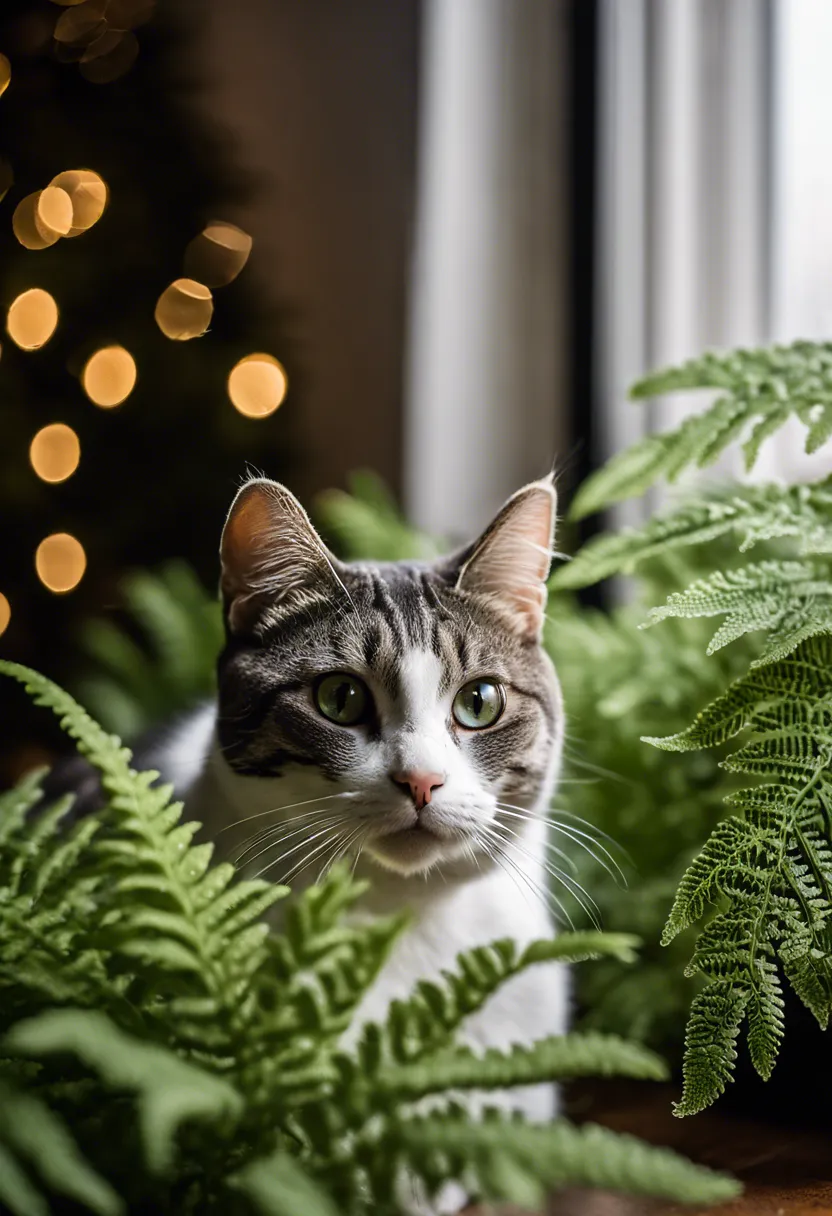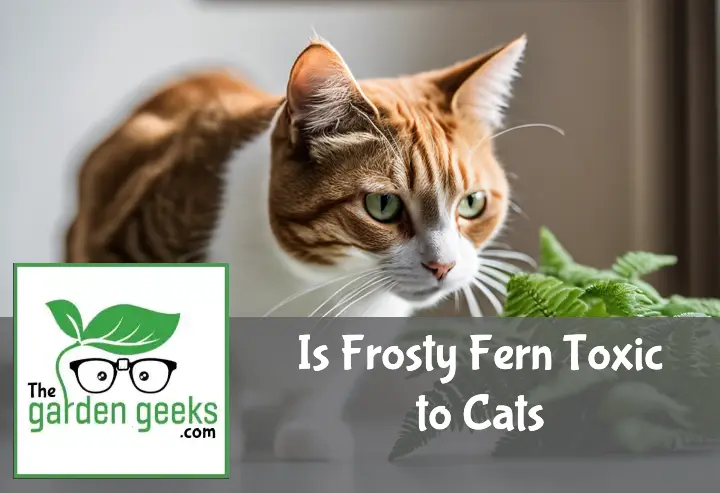Did you know that over a quarter of American households have at least one cat? That’s a lot of feline friends! And as any cat owner knows, these curious creatures love to explore their surroundings, including the plants in your home. One common houseplant is the frosty fern. But Is Frosty Fern Toxic to Cats?
As cat owners, it’s our responsibility to ensure our pets’ safety. This includes being aware of potential dangers lurking in our homes, like certain types of plants. The frosty fern, with its delicate fronds and appealing appearance, can be an attractive nuisance for our feline friends.
So before you decide to bring this plant into your home or if it’s already there, let’s delve into whether or not the frosty fern poses a threat to your beloved cat. Keep reading about Is Frosty Fern Toxic to Cats.
Quick Answer
- Frosty Fern is toxic to cats. If your feline friend munches on this plant, it can lead to some serious health issues.
- The toxic components in Frosty Fern are saponins, which can cause vomiting, diarrhea, and other unpleasant symptoms.
- If your cat ingests Frosty Fern, immediate effects include drooling, loss of appetite and lethargy. Long-term effects could be more severe.
- If you suspect your cat has eaten Frosty Fern, get them to the vet ASAP. In the meantime, try to prevent exposure by keeping these plants out of reach or opting for pet-safe alternatives.

Is Frosty Fern Toxic to Cats?
Identifying the Frosty Fern Plant
Imagine a plant that looks like it stepped out of a winter wonderland. That’s your Frosty Fern. It’s not actually a fern but gets its name from its frost-like appearance. This plant has soft, needle-like leaves that seem dusted with snow. You’ll often find it indoors because it loves the cozy warmth of homes.
Frosty Ferns thrive in moist, shady spots. They’re popular during the holidays but can brighten up a room all year round. Recognizing this plant is key to keeping your furry friends safe.
Toxic Components in Frosty Fern
Now, you might wonder, “What’s the big deal with Frosty Ferns?” Well, they contain compounds that are no party for your cat’s stomach. While not deadly, these plants can cause some discomfort if munched on.
The trouble starts when your curious cat decides to take a bite. The toxic elements in plants like these can irritate their mouth and tummy, leading to symptoms we’ll talk about next. It’s important to know what makes these plants unfriendly to cats so you can keep them apart.
Symptoms of Poisoning in Cats
If your cat has decided that a Frosty Fern is its next snack, watch out for signs like drooling or vomiting. These are immediate red flags. Your cat might also act like it’s not feeling well, being less playful or not eating much.
Sometimes, the symptoms can take a while to show up. If you notice anything odd and know they’ve been exploring the plants, it’s vet time! Better safe than sorry when dealing with symptoms after eating toxic plants.
How Does Frosty Fern Affect Cats?
Cats and Frosty Fern might not be the best mix. Let’s dive into why.
Immediate Effects on Cat Health
When a cat gets too curious about a Frosty Fern, things can go south quickly. If they nibble on it, the first thing you might notice is your cat acting weird. They might drool more than usual or start vomiting. It’s like their body is saying, “Nope, don’t like that!” And this reaction can happen pretty fast, sometimes within minutes.
The severity of these symptoms can vary. Some cats might just feel a bit off and hide under the bed. Others might have it worse, with non-stop puking or diarrhea. It’s kind of like how some people can eat super spicy food and be fine, while others… not so much.
These immediate reactions usually don’t last too long. With proper care, most cats bounce back in a day or two. But during that time, they’re definitely not having fun. It’s important to keep an eye on them and make sure they’re drinking water to stay hydrated.
Long-Term Health Implications
Now, if a cat keeps snacking on Frosty Fern, we’re looking at bigger problems. Imagine eating something that makes you sick every single day. Not good, right? That’s what repeated exposure to Frosty Fern can do to cats.
Over time, this can lead to more serious health issues. We’re talking about long-term damage to their digestive system or even liver problems. The exact effects depend on how often they’re munching on the plant and how their body handles it.
The prognosis for these cases varies widely. For some cats, stopping their access to Frosty Fern and getting treatment early can make a huge difference. They might need medications or special diets to help their bodies recover.
But for others, especially if the problem isn’t caught early enough, the outlook can be more serious. Chronic conditions could develop, requiring ongoing care and possibly affecting their quality of life.
In summary, keeping your furry friend away from Frosty Fern is the best way to avoid these issues altogether. If they do get into it, watching for immediate symptoms and seeking vet care promptly is key to preventing long-term health problems.



What to Do If Your Cat Ingests Frosty Fern?


If your fluffy friend has decided that a frosty fern snack was on their menu today, don’t panic! Here’s a simple guide on what steps to take next. Remember, acting quickly can make all the difference.
-
Identify the amount of frosty fern your cat has eaten. If you caught them in the act, try to figure out how much of the plant is missing. This will be super helpful when you talk to a vet.
-
Observe your cat for any immediate symptoms. These might include drooling, vomiting, diarrhea, or acting more tired than usual. Keep a close eye on them because these signs can help the vet understand how serious the situation is.
-
Call your veterinarian or an emergency pet hotline as soon as possible. Time is of the essence here, folks! Explain what happened and share any symptoms you’ve noticed in your cat.
-
Follow the professional advice given by your vet or the pet poison helpline. They might tell you to bring your cat in for a check-up or give specific instructions on what to do at home.
-
Prevent future incidents by keeping frosty ferns and other potentially toxic plants out of paw’s reach. Cats are curious creatures, and it’s always better to be safe than sorry when it comes to their environment.
Remember, even if frosty fern isn’t known as the most toxic plant out there, it’s always better to err on the side of caution when it comes to our furry family members’ health and safety.
Preventing Cat Exposure to Frosty Fern
Keeping your curious cat away from a frosty fern is crucial, especially since we’re not entirely sure if it’s a friend or foe to our feline friends. Let’s dive into some practical tips that can help you keep these potentially harmful plants out of your cat’s reach. Remember, it’s better to be safe than sorry when it comes to the health and safety of your pets.
-
Place the plant out of reach: This might seem obvious, but sometimes the simplest solutions are the most effective. Put your frosty ferns on high shelves or in rooms where your cat doesn’t go. Cats are great jumpers, so make sure “out of reach” really means they can’t get to it.
-
Use plant stands: Plant stands are not just for decoration; they can also be a barrier between your cat and the frosty fern. Choose stands that are tall and have a narrow top, making it difficult for cats to balance on them or knock the plant over.
-
Apply natural deterrents: Cats dislike certain smells like citrus or vinegar. Spraying a mild solution around the plant can keep your cat at bay without harming the plant. Just make sure whatever you use is safe for both the plant and your pet.
-
Create a distraction: Sometimes, all a cat needs is something better to do. Offering more appealing alternatives like new toys, cat grass, or interactive playtime can divert their attention away from where it shouldn’t be.
-
Train your cat: Yes, cats can be trained! Using positive reinforcement methods like treats and praise when they stay away from the frosty fern (and other off-limits areas) can teach them what’s allowed and what’s not.
Remembering these tips and applying them consistently can help ensure that both your frosty fern and your furry friend stay safe and happy.
Alternatives to Frosty Fern for Pet Owners
| Plant Name | Toxicity Level to Cats | Additional Notes |
|---|---|---|
| Spider Plant | Non-Toxic | Easy to care for and safe for cats |
| Boston Fern | Non-Toxic | Requires a humid environment |
| Areca Palm | Non-Toxic | Also known as the Butterfly Palm |
| Swedish Ivy | Non-Toxic | Thrives in bright, indirect light |
| Bamboo Palm | Non-Toxic | Safe for cats and helps purify the air |
| Barberton Daisy | Non-Toxic | Also known as Gerbera Daisy, it’s safe and adds color to your home decor |
| Blue Echeveria | Non-Toxic | A type of succulent that’s safe for cats |
| African Violet | Non-Toxic | Blooms several times a year with proper care |
To Wrap Up
So, you’ve been wondering, Is Frosty Fern Toxic to Cats? We’ve learned that while it’s not deadly, it can cause some nasty side effects if your kitty takes a bite.
Always remember to keep this plant out of reach from your feline friends. It’s better to be safe than sorry.
Finally, always have your vet’s number handy in case your cat does get into something they shouldn’t. They’re there to help!


FAQs about ‘Is Frosty Fern Toxic to Cats?’.
What other plants are toxic to cats besides Frosty Fern?
There are numerous plants that can be harmful to cats. Some of the most common include lilies, azaleas, oleander, and sago palm. Always research a plant’s toxicity before bringing it into a home with pets.
How can I identify a Frosty Fern if I’m unsure?
Frosty ferns have small, scale-like leaves that cover the entire stem. They often have a frosty or sparkly appearance due to tiny white hairs on the leaves.
Are there any non-toxic alternatives to Frosty Fern for cat owners?
Yes, there are many cat-safe plants you can choose instead of frosty ferns. Spider plants, Boston ferns, and certain types of orchids are all safe for cats.
My cat has ingested some Frosty Fern but seems fine. Should I still be worried?
Even if your cat seems fine initially after eating frosty fern, complications can arise later. It’s always best to consult with a vet as soon as possible after ingestion.
Can my cat recover fully after ingesting Frosty Fern?
With prompt veterinary care, most cats can make a full recovery after ingesting toxic plants like frosty ferns. However, severe cases may require extensive treatment and carry long-term health risks.


